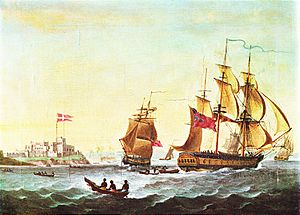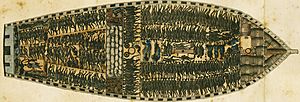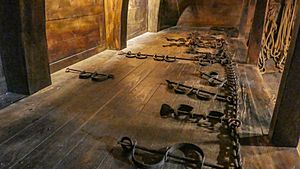Thomas Foxcroft (slave trader) facts for kids
Thomas Foxcroft (1733–1809) was an English slave trader. This means he was involved in buying and selling people from Africa, forcing them onto ships, and transporting them across the Atlantic Ocean to be sold as slaves. He organized at least 91 such voyages between 1759 and 1792. For one of his ships, called the Bloom, we have records showing that its captain bought 349 enslaved people in Africa. Tragically, 42 of these people died during the journey. The remaining 307 people were sold in the West Indies for a large sum of money.
Contents
Early Life of Thomas Foxcroft
Thomas Foxcroft was born in a place called Thornton in Lonsdale, which is in Yorkshire, England. His father's name was George Foxcroft.
Thomas Foxcroft and the Slave Trade
Thomas Foxcroft became involved in the slave trade through his family connections. His sister, Agnes, married into the Welch family in 1752. The Welch family was very active in the slave trade. This connection likely led Foxcroft to move to Liverpool, a major port for slave ships at the time. From Liverpool, he began his own slave trading business.
He often worked with other slave traders, including George Welch and James Welch. In 1759, he also invested in a slave voyage with John Welch. Thomas Foxcroft's niece, Mary Foxcroft, later married one of his regular business partners, Felix Doran. After Felix Doran passed away in 1776, Foxcroft continued to work with Doran's son, who was also named Felix Doran.
The Ship Bloom
Thomas Foxcroft was an owner of the slave ship Bloom. We have records from a voyage the Bloom made in 1784. These records show how much it cost to buy enslaved people, how much profit was made, and the value placed on the people being transported.
The captain of the Bloom, Robert Bostock, bought 349 enslaved people from the Windward Coast of Africa. He then transported them to the West Indies to be sold. Sadly, 42 people died during the journey or shortly after arriving before they could be sold. Of the 307 people who were sold, 103 were men, 51 were women, 99 were boys, and 54 were girls. They were sold for a total of £9858 (which would be worth much more today, about equivalent to £960,000 in 2021). Historians have noted that Foxcroft made a very large profit from the sale of these captive Africans.
The first Bloom ship was taken apart in 1789. Its owners, including Foxcroft, replaced it with a new ship, also named Bloom.
Changes in the Slave Trade
In 1793, the Port of Liverpool faced financial difficulties. This might have caused many of the slave trading partners to stop their involvement in the business. At that time, they still owned three slave ships: the Bloom, King Grey, and Bud.
The Bloom and Bud were sold when they returned to Liverpool in 1793. However, John Welsh kept some ownership in the Bud. The King Grey was captured by a French privateer (a type of armed ship) in 1793. Luckily, a British warship, HMS Hyaena, quickly recaptured the King Grey. The ship and its cargo of enslaved people were then sold in Kingston. The captain and crew were also rescued.
By 1793, Thomas Foxcroft was 60 years old. He had started investing in the slave trade when he was 26, and by 1793, he had been involved in 92 such voyages.
Foxcroft's Family Home
Foxcroft's family home was called Halsteads, located in Thornton in Lonsdale. In his will, Foxcroft left a large part of his property to his nephew, Reverend Thomas Hammond Foxcroft, who lived at Halsteads. Halsteads is considered an important historical building and has been officially recognized as a Grade II listed building since February 1958.




